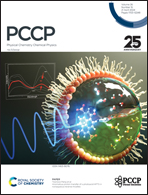The thermal decomposition mechanism of RDX/AP composites: ab initio neural network MD simulations†
Abstract
A neural network potential (NNP) is developed to investigate the decomposition mechanism of RDX, AP, and their composites. Utilizing an ab initio dataset, the NNP is evaluated in terms of atomic energy and forces, demonstrating strong agreement with ab initio calculations. Numerical stability tests across a range of timesteps reveal excellent stability compared to the state-of-the-art ReaxFF models. Then the thermal decomposition of pure RDX, AP, and RDX/AP composites is performed using NNP to explore the coupling effect between RDX and AP. The results highlight a dual interaction between RDX and AP, i.e., AP accelerates RDX decomposition, particularly at low temperatures, and RDX promotes AP decomposition. Analyzing RDX trajectories at the RDX/AP interface unveils a three-part decomposition mechanism involving N–N bond cleavage, H transfer with AP to form Cl-containing acid, and chain-breaking reactions generating small molecules such as N2, CO, and CO2. The presence of AP enhances H transfer reactions, contributing to its role in promoting RDX decomposition. This work studies the reaction kinetics of RDX/AP composites from the atomic point of view, and can be widely used in the establishment of reaction kinetics models of composite systems with energetic materials.



 Please wait while we load your content...
Please wait while we load your content...